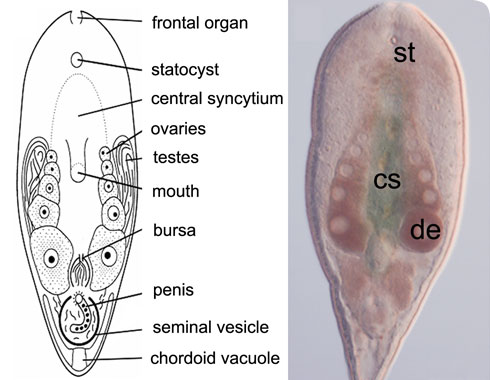Biology
Although born without algae, Symsagittifera roscoffensis acquires algal cells from the surrounding water within days of hatching - as many as 25,000 algae have been found in a single adult worm. The adult worms are entirely dependent on the symbionts for nutrients. Indeed, the symbiosis is so important to the acoel that it adjusts its lifestyle entirely to optimise the photosynthetic activities from which it derives its nutrition.
Acoels have no body cavity (a-coel) and usually a syncitial blind-ending digestive tract (a fusion of cells, within which vacuoles form around food that is ingested, and no anus). Although it has sensory organs, a simple nervous system, and often a complex organisation of musculature, it is the lack of features that has long suggested the possible role of acoels as models for ancestral bilaterians. They lack:
- a circulatory system
- a respiratory system
- a true brain
- gonads
Acoels are sequential hermaphrodites – they produce gametes in mesenchymal cells that fill their bodies. Lacking an oviduct, eggs are layed through ruptures in the body wall.
The worms lack any hard cuticular parts, and therefore it is not surprising that acoels have no fossil record.
Acoels have stem cells - undifferentiated cells with the potential to self-renew. Many animals possess stem cells, but acoels and true flatworms (platyhelminths) have ‘totipotent’ stem cells called neoblasts that can differentiate into any kind of cell if needed. As such, they are important model organisms for understanding development and regeneration.
